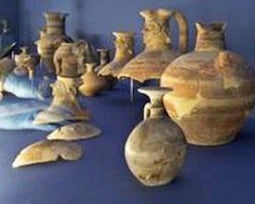
The exhibition focuses on the deep connections between the two great civilizations of the Mediterranean, who traded both goods and cultures for centuries.The exhibit takes place in the premises of the Thessaloniki Archaeological Museum and can be visited until June 20th, 2012.
The exhibit has two parallel paths: the first one focuses on how the connections between the two people developed over time, starting at the beginning of the Late Copper Age (Aeneolithics) until destruction of Phoenician cities by Alexander the Great (around 333 b.C.) and Hellenization of the East.
The second path focuses on the sectors of cooperation between the two civilizations, such as religion, art and the development of the alphabet.
The goal of the exhibition, as the Director of the Archaeological Musem Polyxeni Adam explained during a press conference is to ”show interactions between the Greek and the Phoenicia and the other way round”.
The exhibition’s curator Liana Stefani also explained that the exhibition was organized according to the development in time of the relations between the Greek and the Phoenicia from the XI century b.C. until the conquer of Thyros in 332 b.C.” According to Museum sources, next year a scientific catalogue of the exhibition will be published, while a day of scientific studies is to be organized in spring 2012.
On this occasion, some sector experts will explain the most recent studies carried out on the issue of Greek-Phoenicia relations.
The archaeological finds exhibited in Thessaloniki come from several museums, including the Beirut American University (UAB) Museum, The Athens National Archaeological Museum, the Delphi Museum and the Heraklion Archaeological Museum (in Crete) and from eight Antiquities Superintendent Departments from all over Greece.
Among the 131 exhibited archaeological finds, there are vases shaped like birds that were found in the Proto-Minoan tombs of Crete and other vases found in the tombs of Knossos and Archanes, a small copper statue of a “God who hits” (this is its name), a marble column of Hermia coming from Tyros found in Dilos, an ivory comb and other exquisitely made items.
The periods when trade relations between ancient Greece and the Phoenicia were at their closest and most intense are testified not only by archaeological finds, but also by detailed geographical maps.
(source: ANSA)
See all the latest news from Greece and the world at Greekreporter.com. Contact our newsroom to report an update or send your story, photos and videos. Follow GR on Google News and subscribe here to our daily email!



